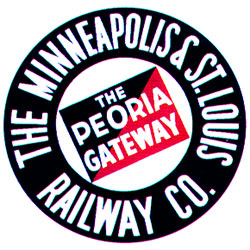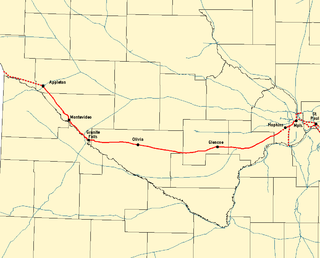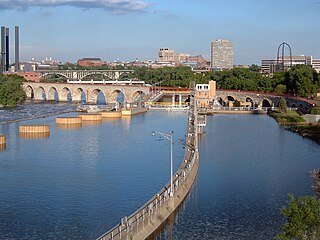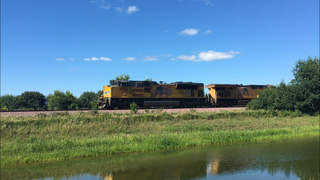Related Research Articles

Saint Paul's Union Depot is a historic railroad station and intermodal transit hub in the Lowertown neighborhood of the city of Saint Paul, Minnesota, United States. It serves light rail, intercity rail, intercity bus, and local bus services.

The Dakota, Minnesota and Eastern Railroad was a Class II railroad subsidiary of the Canadian Pacific Railway operating across South Dakota and southern Minnesota in the Northern Plains of the United States. Portions of the railroad also extend into Wyoming, Nebraska, Iowa, and Illinois.

The Minneapolis, Northfield and Southern Railway was an 87-mile (140 km) long American shortline railroad connecting Minneapolis and Northfield, Minnesota. It was incorporated in 1918 to take over the trackage of the former Minneapolis, St. Paul, Rochester and Dubuque Electric Traction Company, also known as the Dan Patch Lines. On June 2, 1982, it was acquired by the Soo Line Railroad, which operated it as a separate railroad until merging it on January 1, 1986 along with the Chicago, Milwaukee, St. Paul and Pacific Railroad.

The Chicago, St. Paul, Minneapolis and Omaha Railway or Omaha Road was a railroad in the U.S. states of Nebraska, Iowa, Minnesota, Wisconsin and South Dakota. It was incorporated in 1880 as a consolidation of the Chicago, St. Paul and Minneapolis Railway and the North Wisconsin Railway. The Chicago and North Western Railway (C&NW) gained control in 1882. The C&NW leased the Omaha Road in 1957 and merged the company into itself in 1972. Portions of the C. St. P. M. and O. are part of the Union Pacific Railroad network. This includes main lines from Wyeville, Wisconsin, to St. Paul, Minnesota, and St. Paul to Sioux City, Iowa.

The Minneapolis and St. Louis Railway (M&StL) was an American Class I railroad that built and operated lines radiating south and west from Minneapolis, Minnesota for 90 years from 1870 to 1960. The railway never reached St. Louis but its North Star Limited passenger train ran to that city via the Wabash Railroad.

St. Paul Union Pacific Rail Bridge, also known as the Hoffman Swing Bridge, is a swing bridge that spans the Mississippi River between South Saint Paul, Minnesota and Saint Paul, Minnesota in the United States. It was built in 1910 by the St. Paul Bridge and Terminal Railway, and was rebuilt in 1925, after a flood in 1951, and again in 1982.

The Twin Cities and Western Railroad is a railroad operating in the U.S. state of Minnesota which started operations on July 27, 1991. Trackage includes the former Soo Line Railroad "Ortonville Line", originally built as the first part of the Pacific extension of the Milwaukee Road. This main line extends from Hopkins, Minnesota to Appleton, Minnesota. The line was originally built between Hopkins and Cologne, Minnesota in 1876 by Hastings and Dakota Railroad. In 1913, the Milwaukee Road rerouted it, reducing the curves. The line was eventually extended to the Pacific.

Transportation in the U.S. State of Minnesota consists of a complex network of roadways, railways, waterways and airports. The transportation system is generally overseen by the Minnesota Department of Transportation, a cabinet-level agency of the state government. Additionally, regional governments such as the Metropolitan Council have authority over regional planning for the transportation system and local governments such as cities and counties oversee the local transportation network.

The Amtrak Hudson Line, also known as the CSX Hudson Subdivision, is a railroad line owned by CSX Transportation and leased by Amtrak in the U.S. state of New York. The line runs from Poughkeepsie north along the east shore of the Hudson River to Rensselaer and northwest to Hoffmans via Albany and Schenectady along a former New York Central Railroad line. From its south end, CSX has trackage rights south to New York City along the Metro-North Railroad's Hudson Line. The Hudson Line junctions the Castleton Subdivision in Stuyvesant, Amtrak's Post Road Branch in Rensselaer and the Carman Subdivision in Schenectady. Its northwest end is at a merge with the Mohawk Subdivision.
There are several passenger rail projects being discussed in Minnesota. There is one existing commuter rail service in the state, the Northstar Line, and one existing long-distance intercity rail service, the Empire Builder. Future projects include a mixture of short-distance commuter rail and medium-distance regional rail lines which would run from the Twin Cities outward to neighboring states and perhaps Canada.

The Minneapolis Great Northern Depot, also known as Great Northern Station, was a passenger railroad station which served Minneapolis, Minnesota, USA. It was built in 1913 and demolished in 1978. It was located on Hennepin Avenue next to the Hennepin Avenue Bridge and across the street from the main Minneapolis Post Office.
The Northern Lights Express (NLX) is a planned higher-speed rail service that would run 155 miles (249 km) between Minneapolis and Duluth primarily in the U.S. state of Minnesota. A portion of the proposed line would run through neighboring Wisconsin to serve Duluth's "Twin Port" of Superior. Plans are to upgrade an existing BNSF Railway freight line to allow trains to travel at up to 90 miles per hour (145 km/h). The train service is said to provide an alternative to traveling Interstate 35 between Duluth and the Twin Cities or to other destinations along the line such as the casino in Hinckley.

The Dan Patch Corridor is a proposed commuter rail line that would serve a region which runs from Minneapolis to Northfield, Minnesota. The corridor consists of the tracks on the former Minneapolis St. Paul Rochester and Dubuque Electric Traction Company lines, which came to be known as the Dan Patch lines. It was proposed as a passenger rail line in 2000 after being identified as a "Tier One" corridor in the Minnesota Department of Transportation's 2000 Commuter Rail System Plan before being given a study ban during the 2002 Minnesota legislative session. It sat in relative silence until 2008, when bills were introduced in the Minnesota State Legislature to potentially revive discussion.

The Dan Patch Line Bridge is a railroad swing bridge that carries the Canadian Pacific Railway's MN&S Subdivision across the Minnesota River. The MN&S Subdivision originated as the Minneapolis, St. Paul, Rochester and Dubuque Electric Traction Company, more commonly known as the Dan Patch Lines. Today's name for the rail line comes from the Minneapolis, Northfield and Southern Railroad, which took over the Dan Patch route after the original railroad fell into bankruptcy. Despite being met by Canadian Pacific rails at either end, the bridge itself is owned by the Twin Cities and Western Railroad which has trackage rights on the CP line to the north. The TC&W purchased the bridge in order to protect a route that may become important in the future.

The Burlington, Cedar Rapids and Northern Railway (BCR&N) was a railroad that operated in the United States from 1876 to 1903. It was formed to take over the operations of the bankrupt Burlington, Cedar Rapids and Minnesota Railway, which was, in turn, the result of merging several predecessor lines, the construction of which began in 1869. The corporate headquarters were in Cedar Rapids, Iowa, and it had operations in Iowa and in Minnesota. It was succeeded by the Chicago, Rock Island and Pacific Railway.
The Mankato Subdivision or Mankato Sub is a railway line operated by the Union Pacific Railroad. It runs generally southwest, starting at Chestnut Street in Saint Paul, Minnesota, where it crosses the Mississippi River, then runs south along the Mississippi and then the Minnesota River to Mankato, where it turns away from the river and continues west to St. James. From there Union Pacific's rails continue southwest toward Sioux City, Iowa, as the railroad's Worthington Subdivision.

Union Station, also known as Union Station and Burlington Freight House, is located near the riverfront in downtown Davenport, Iowa, United States. It is listed on the National Register of Historic Places. The buildings are in a section of downtown with several historic structures. Across Ripley Street to the west is the Chicago, Milwaukee, St. Paul and Pacific Freight House, and to the east across Harrison Street is the Dillon Memorial. On River Drive northwest from the Burlington Freight House is The Linograph Company Building. Across Beiderbecke Drive to the south are the W.D. Petersen Memorial Music Pavilion and the Mississippi River.
The MN&S Spur is a 18.5-mile (29.8 km) railroad line operated by the Progressive Rail Inc. The route runs through suburbs immediately west of Minneapolis, Minnesota, from MN&S Junction in Crystal south to Auto Club Junction in Bloomington near the Minnesota River. This path is parallel to Minnesota State Highway 100, which is about half a mile east of the rail line.
The Bass Lake Spur is a railroad line owned by the Canadian Pacific Railway that runs 6.8 miles (10.9 km) from Minneapolis, Minnesota west to the suburb of Minnetonka. The primary operator on the line is the Twin Cities and Western Railroad which has trackage rights on the entire line and uses it to run trains from their main line to BNSF Railway's Wayzata Subdivision.

The Altoona Subdivision or Altoona Sub is a 90.7-mile (146.0 km) railway line owned and operated by the Union Pacific Railroad in the states of Minnesota and Wisconsin. The line originates in Saint Paul, Minnesota, crosses the St. Croix River on the Hudson Bridge into Hudson, Wisconsin, and eventually terminates in Altoona, Wisconsin where it connects to the Wyeville Subdivision. This subdivision is formerly a Chicago and North Western Railway (C&NW) mainline, on which the Twin Cities 400 operated in the mid 1900s.
References
- ↑ Brad Joseph (February 15, 2010). "The Last Granger Railroad". C&NW Railfan Guide. Gateway Division NMRA.
- 1 2 D. J. Duffy; et al. (2007). "Twin Cities Area Timetable #3, Effective 0001 Monday, December 17, 2007" (PDF). Union Pacific. Archived from the original (PDF) on July 8, 2011. Retrieved September 28, 2010.
- ↑ Cambridge Systematics, Inc. (July 31, 2009). "Minnesota Comprehensive Statewide Freight and Passenger Rail Plan: Freight Rail Supply and Demand – Draft technical memorandum" (PDF). Minnesota Department of Transportation. pp. 3–16, B-32. Retrieved September 21, 2010.